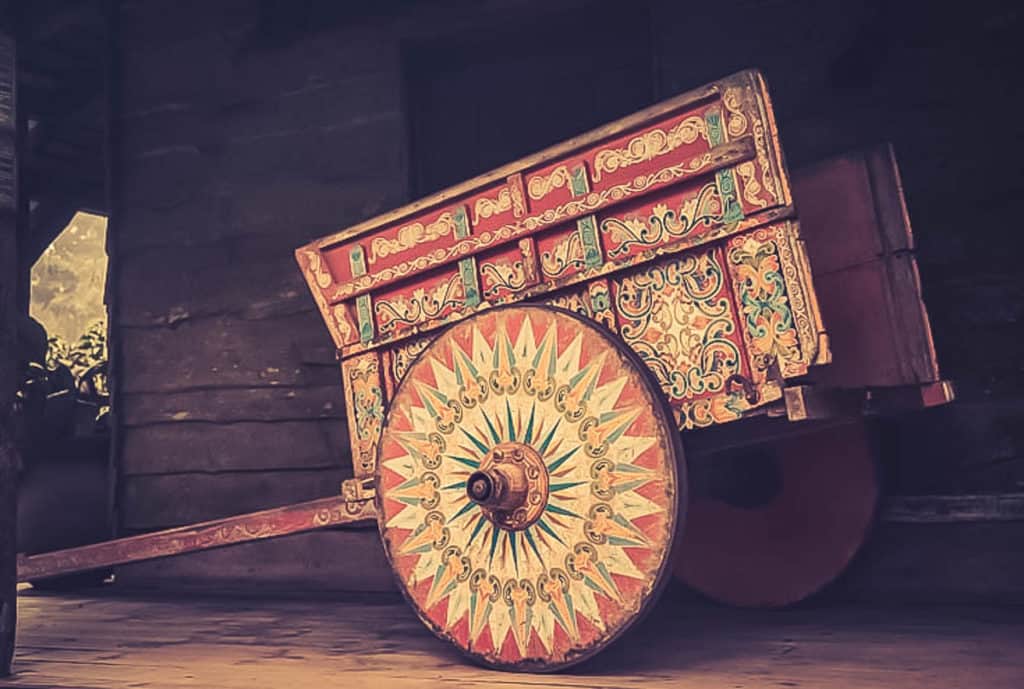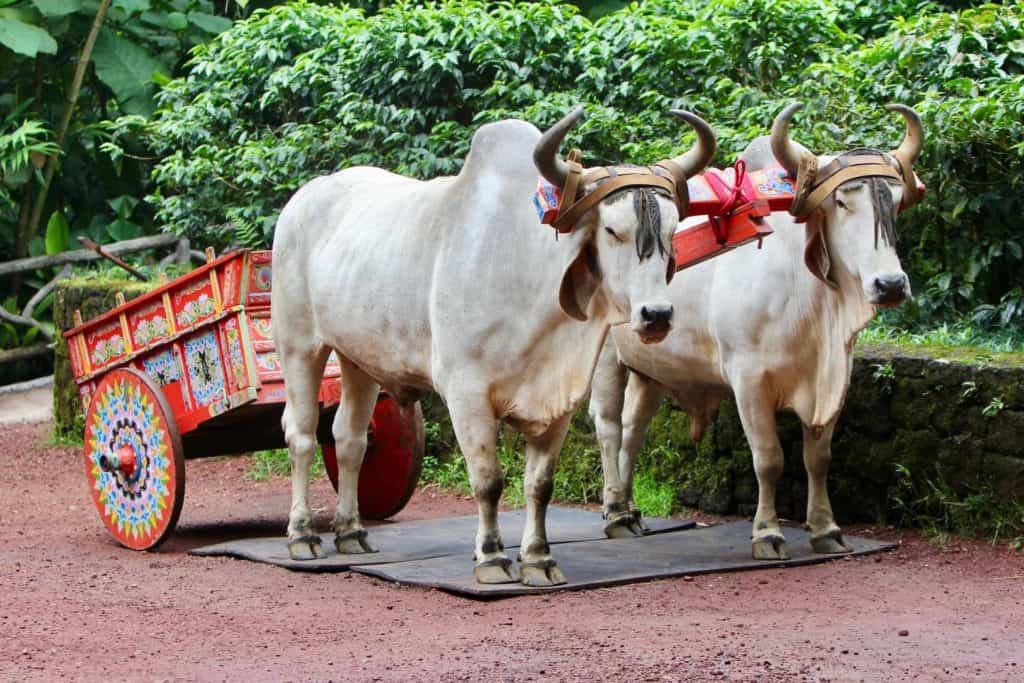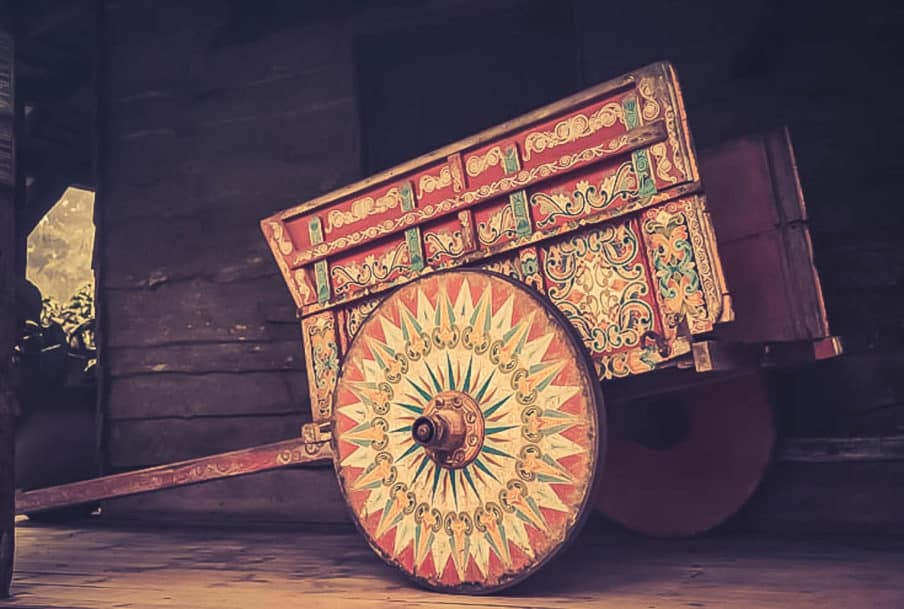
The Costa Rica ox cart is a traditional way of carrying people or produce. The bright and colorful ox cart is a National Symbol of Costa Rica and represents the spirit and vitality of those that live there.
There are many traditions around the world that seem strange for people who aren’t locals to that area. Sometimes, mundane items that you use every day become works of art or centerpieces for a grand celebration.
Today, we’ll be taking a closer look at the brightly colored ox carts of Costa Rica. We will talk about what makes a Costa Rica Ox Cart different, how they are used today as well as in the past. And we will finish up with where you can see them made today.
Ready? Lets get started!
What is a Costa Rican Ox Cart Made Of?
In its most basic terms, an ox cart is an ox-drawn carriage, typically used in Costa Rica to transport people and produce in and around the mountainous terrain of the country. Also known as the Carreta, the main body of the cart is rectangular, and is attached to a yoke that can then be attached to two oxen.
The wheels themselves are a combination of spoked wheels that have been introduced by the Spanish and the block disks used by the Aztecs. This design allowed it to travel through the thick mud that is very common in the country’s wet, tropical climate without sinking.
Now, the ox cart itself is not unique to Costa Rica. In fact, it has seen wide use all over the world before the Spanish even introduced it to the country early in its history. What makes Costa Rica’s ox cart so unique is how entrenched this item is to the traditions of the locals.
How Are Ox Carts Used in Costa Rica?
Nowadays, the use of ox drawn carts as transport is pretty rare. Even in the most remote villages, the use of trucks or other vehicles to move people and goods from one place to another is more common.
Despite this, however, the use of ox carts has remained pretty much alive in the country, just not as a transport. Ox carts are a predominant symbol of Costa Rica’s rural traditions, and are featured prominently in local parades, religious celebrations, and local fiestas.
These ox carts are decorated and painted with bright colors, usually with images of flowers, landscapes, faces, and random geometric shapes. Each region in Costa Rica has their own, unique way of painting these transports. As a matter of fact, it’s even possible to find out where the ox cart came from based on the patterns and designs seen on the wheels.
Each ox cart also has its own “song”, where a series of metal rings attached to the wheel produce a unique sound as the ox cart moves along. The sound is unique to the artisan who built the art itself.
What is the history of the Costa Rica Ox Cart?

The ox carts of Costa Rica didn’t start off as we see them today. In pre-colonial times, the carts used by the Aztecs were mostly hand-drawn, since oxen or horses didn’t exist until Europeans brought them over. It wasn’t until the Spanish came to Costa Rica that the ox cart saw wide use in the area.
Unfortunately for the Spanish, the traditional spoked wheel design used in Europe didn’t do well in the muddy terrains of Central America. The light wheel design kept getting stuck in the soft soil and breaking.
This was when the local artisans began incorporating the Aztec wheel design into their ox carts. The new wheel was a solid block of wood that allowed it to cut through the mud without getting the cart stuck.
During the 1800’s, the traditional ox cart saw much use transporting coffee from the mountains where they were cultivated to the ports on the Pacific and the Caribbean side of Costa Rica.
Nowadays, you can get from the Caribbean side to the Pacific in less than an hour by car, but back in the day, when people had to travel through thick jungle, mountains and wet swamp, the journey could last anywhere between 10 days to an entire month. The ox cart made the entire journey a lot easier.
The tradition of painting ox carts wasn’t done until the early 1900’s. Before then, ox carts were mostly made of wood, and was either tarred or covered in hide leather. The tradition itself started in the town of Sachi, at the Joaquin Chaverri Oxcart Factory.
According to the local legend, Joaquin Chaverry, the owner of the factory, used the oxcarts he made to take his family out on Sundays. He wanted to make the oxcarts he used on these outings to look nice for his family, so he started painting his ox carts orange.
He chose orange because that was the only paint he had available in the shop. Even after the tradition of painting ox carts have spread across Costa Rica, shades of orange have become known as the traditional color of ox carts.
Why Are Ox Carts in Costa Rica So Colorful?
As the tradition of painting ox carts spread across the country, the designs themselves became more elaborate. Eventually, how elaborate the design on the ox cart became somewhat of a status symbol amongst rural families.
Poorer farming families tended to lack both the time and resources to paint an ornate ox cart. It is pretty much understood that a wealthier a family is, the more they can spend on paints and hire a talented artist to pain their cart.
Once the ox cart has evolved into a status symbol, families began using it as a way to show off to their neighbors during important festivities in their towns. So, if there’s a parade, a religious event, or an important fiesta, so too will there be highly-elaborate ox-drawn carts with the families of townspeople riding them.
The Town of Sarchi
Sarchi is the birthplace of Costa Rica’s colorful ox carts. In fact, Sarchi has been producing ox carts for more than 120 years, long before the tradition of painting them with bright colors have been widespread. The last factory that still produces these handmade ox carts in Costa Rica is located here. The production itself involves minimal use of machines, so the factory itself only produces 3 ox carts a month.
Aside from the factory itself, Sarchi is also home to the world’s largest ox cart, which is on display at the Sarchi Central Park, located at a church north of the town.
There is also a handicraft market where you can buy a huge collection of handmade souvenirs. Of course, if you’re more into spending time in nature, the Juan Castro National Park or the Poas Volcano is close by for a tour.
Final Thoughts
Any trip to Costa Rica should include a trip to Sarchi, especially if you are visiting Poas Volcano or coming from or going to Arenal. Its a great way to learn a little about this part of Costa Rica’s history and at the same time pick up a few things to remember your trip to Costa Rica.

